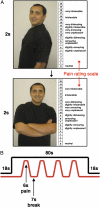Attachment figures activate a safety signal-related neural region and reduce pain experience
- PMID: 21709271
- PMCID: PMC3136329
- DOI: 10.1073/pnas.1108239108
Attachment figures activate a safety signal-related neural region and reduce pain experience
Abstract
Although it has long been hypothesized that attachment figures provide individuals with a sense of safety and security, the neural mechanisms underlying attachment-induced safety have not been explored. Here, we investigated whether an attachment figure acts as a safety signal by exploring whether viewing an attachment figure during a threatening experience (physical pain) led to increased activity in a neural region associated with safety signaling, the ventromedial prefrontal cortex (VMPFC), and corresponding reductions in pain. Female participants in long-term romantic relationships were scanned as they received painful stimuli while viewing pictures of their partner and control images (stranger, object). Consistent with the idea that the attachment figure may signal safety, results revealed that viewing partner pictures while receiving painful stimulation led to reductions in self-reported pain ratings, reductions in pain-related neural activity (dorsal anterior cingulate cortex, anterior insula), and increased activity in the VMPFC. Moreover, greater VMPFC activity in response to partner pictures was associated with longer relationship lengths and greater perceived partner support, further highlighting a role for the VMPFC in responding to the safety value of the partner. Last, greater VMPFC activity while viewing partner pictures was associated with reduced pain ratings and reduced pain-related neural activity. An implication of these findings is that, in the same way that stimuli that historically have threatened survival (e.g., snakes, spiders) are considered to be prepared fear stimuli, attachment figures, who have historically benefited survival, may serve as prepared safety stimuli, reducing threat- or distress-related responding in their presence.
Conflict of interest statement
The authors declare no conflict of interest.
Figures



References
-
- Bowlby J. A Secure Base: Parent-Child Attachment and Healthy Human Development. USA: Basic Books; 1988. p. 27.
-
- Bowlby J. Attachment. USA: Basic Books; 1969.
-
- Hazan C, Shaver P. Romantic love conceptualized as an attachment process. J Pers Soc Psychol. 1987;52:511–524. - PubMed
-
- Kulik JA, Mahler HIM. Social support and recovery from surgery. Health Psychol. 1989;8:221–238. - PubMed
-
- Kennell J, Klaus M, McGrath S, Robertson S, Hinkley C. Continuous emotional support during labor in a US hospital. A randomized controlled trial. JAMA. 1991;265:2197–2201. - PubMed
MeSH terms
LinkOut - more resources
Full Text Sources
Other Literature Sources
Medical

